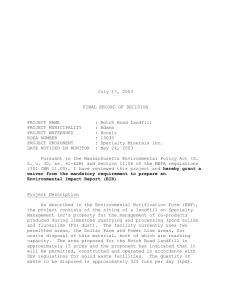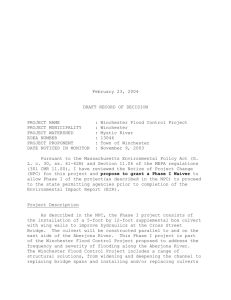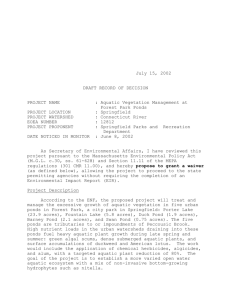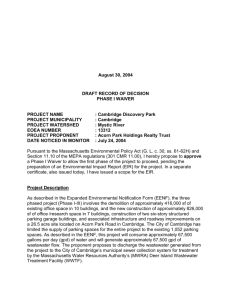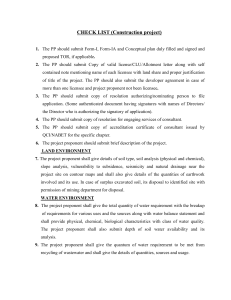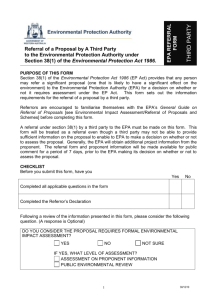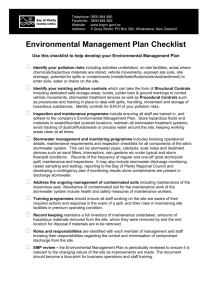Parkway Plaza Redevelopment
advertisement
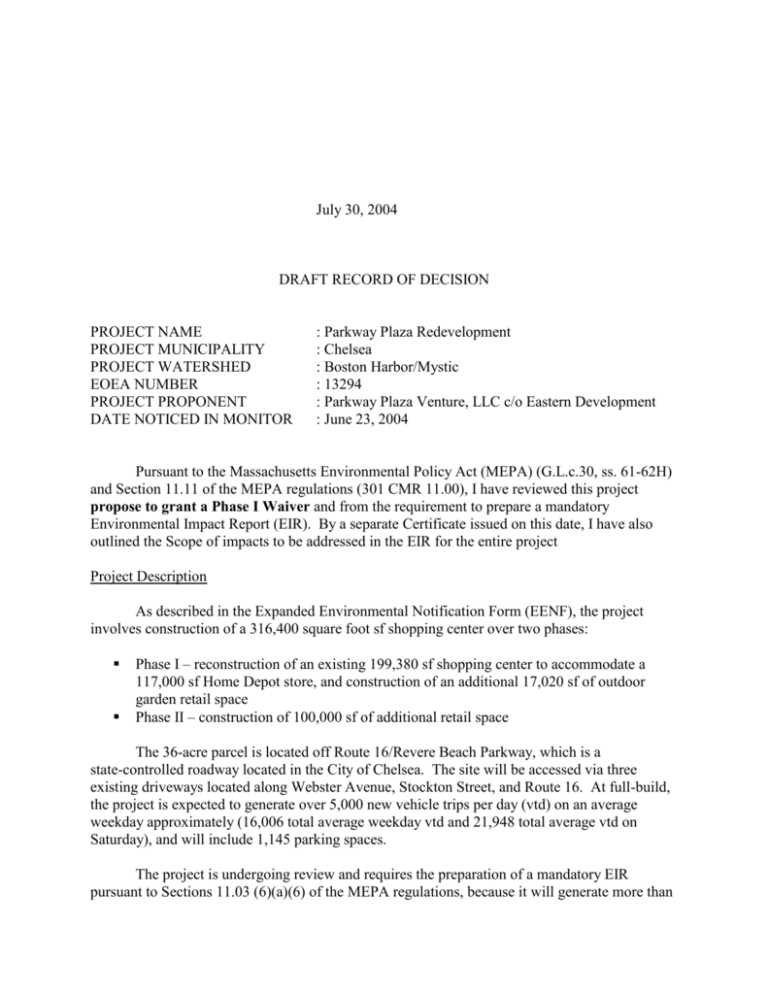
July 30, 2004 DRAFT RECORD OF DECISION PROJECT NAME PROJECT MUNICIPALITY PROJECT WATERSHED EOEA NUMBER PROJECT PROPONENT DATE NOTICED IN MONITOR : Parkway Plaza Redevelopment : Chelsea : Boston Harbor/Mystic : 13294 : Parkway Plaza Venture, LLC c/o Eastern Development : June 23, 2004 Pursuant to the Massachusetts Environmental Policy Act (MEPA) (G.L.c.30, ss. 61-62H) and Section 11.11 of the MEPA regulations (301 CMR 11.00), I have reviewed this project propose to grant a Phase I Waiver and from the requirement to prepare a mandatory Environmental Impact Report (EIR). By a separate Certificate issued on this date, I have also outlined the Scope of impacts to be addressed in the EIR for the entire project Project Description As described in the Expanded Environmental Notification Form (EENF), the project involves construction of a 316,400 square foot sf shopping center over two phases: Phase I – reconstruction of an existing 199,380 sf shopping center to accommodate a 117,000 sf Home Depot store, and construction of an additional 17,020 sf of outdoor garden retail space Phase II – construction of 100,000 sf of additional retail space The 36-acre parcel is located off Route 16/Revere Beach Parkway, which is a state-controlled roadway located in the City of Chelsea. The site will be accessed via three existing driveways located along Webster Avenue, Stockton Street, and Route 16. At full-build, the project is expected to generate over 5,000 new vehicle trips per day (vtd) on an average weekday approximately (16,006 total average weekday vtd and 21,948 total average vtd on Saturday), and will include 1,145 parking spaces. The project is undergoing review and requires the preparation of a mandatory EIR pursuant to Sections 11.03 (6)(a)(6) of the MEPA regulations, because it will generate more than EOEA #13294 DRAFT Record of Decision July 30, 2004 3000 new average daily trips on a roadways providing access to a single location. The project requires Access Permits from both the Massachusetts Highway Department (MHD) and the Department of Conservation and Recreation (DCR) since the site abuts the state highway layouts of Route 1 and Route 16. The proponent is also seeking a Chapter 91 License (for existing construction on filled tidelands, and a proposed walkway along the Mill Creek) and a Sewer Extension /Connection Permit from the Department of Environmental Protection (DEP). The Office of Coastal Zone Management (CZM) will also review the project to issue a Finding of Consistency with CZM policies. The project also requires an Order of Conditions from the Chelsea Conservation Commission for work in the buffer zone. The proponent is not seeking Commonwealth financial assistance to construct the project. Therefore, MEPA jurisdiction is limited to those aspects of the project within the subject matter of required or potentially required permits that have the potential to cause significant Damage to the Environment. In this case, MEPA jurisdiction covers traffic, wetlands, stormwater, and wastewater impacts. Waiver Request On June 15, 2004, the proponent requested a Phase I Waiver from the requirement for the preparation of an EIR. A "Traffic Impact Study" was prepared and submitted with the Expanded ENF. The waiver request was discussed at the consultation/scoping session, which was held on July 7, 2004. Criteria for Waiver Section 11.11 of the MEPA Regulations provides that a waiver may be granted upon a finding that strict compliance with the regulations will result in undue hardship and will not serve to minimize or avoid damage to the environment. In the case of categorically included projects, this finding shall be based on one or more of the following circumstances: 1) the project is likely to cause no damage to the environment; and 2) ample and unconstrained infrastructure exists to support the project. The terms agreed to as a condition of the waiver will bring about benefits in excess of those that could be achieved in the absence of a waiver. Findings Based upon the information submitted by the proponent and after consultation with the relevant state agencies, I find that: 1. Although the potential traffic impacts of the project are not insignificant, sufficient mitigation measures will be provided. The proponent has documented the project's traffic impacts in the traffic study submitted with the EENF. According to the analysis, the project is estimated to generate approximately 2,190 new weekday vtd (1,370 new vtd on Saturday) as 2 EOEA #13294 DRAFT Record of Decision July 30, 2004 compared to a fully occupied shopping center. The proponent has committed to traffic signal upgrades, signal timing modifications, and changes in roadway geometry to mitigate the traffic impacts of the project. Phase I also includes installation of internal and external sidewalks to facilitate pedestrian access to and circulation through the project site. The proponent should commit to monitoring traffic volumes at and Level of Service at key intersections, and reporting the results to MHD. Additional mitigation may be warranted based on the outcome of the analysis. 2. The proponent will implement a Transportation Demand Management (TDM) Program that will include an MBTA subsidized monthly pass program for full-time employees. The proponent should also discuss with the MBTA the feasibility of extending bus service to the site. 4. Ample and unconstrained infrastructure exist for water and wastewater service. The proponent has committed to extending a new 10-inch ductile iron, cement lined water main water through the site, which will connect to the existing main on Webster Avenue. The proposed sanitary sewer system will consist of new PVC piping which will connect to the existing manhole located behind the former Bradlees building. To mitigate the water supply impacts of the project, the project includes landscaping with drought-resistant vegetation. The proponent should also consider upgrading the Locke Street water main, which the EENF notes is in poor condition. 5. The proponent plans to utilize hooded deep sump catch basins and Vortechnics oil/particle separators to treat all stormwater from the proposed catch basins. According the EENF, the proposed stormwater system will divert approximately 32.8 cubic feet per second of stormwater to a new drainage outlet, during a ten-year storm event. The outlet will discharge to a deeper portion of the Mill River than the existing outlet, reducing the potential for erosion and sedimentation. In addition, the outlet will be constructed further downgradient of the existing structure to minimize water quality impacts to the Locke Street Salt Marsh, which is slated for restoration. The proponent, however, must confirm with DEP that the proposed outlet design and location will achieve the anticipated result, and minimize the stormwater impacts of the project. The proponent has also committed to performing regular inspections and maintenance of the stormwater collection system, and to initiating a seasonal sweeping program of its roadways and parking areas. The proponent must incorporate all feasible Best Management Practices pursuant to DEP's Stormwater Management Policy and ensure that the proposed system achieves the Total Suspended Solid removal requirement to mitigate impacts to the adjacent Mill Creek and associated marine fisheries resources, and the salt marsh. The proponent has committed to coordinating with MHD to ensure that access to an existing drainage ditch is maintained during and after construction. 3 EOEA #13294 DRAFT Record of Decision July 30, 2004 To further mitigate the stormwater impacts of the project, the proponent should also evaluate the feasibility of separating clean roof runoff from the stormwater conveyance system. Stormwater could then be used onsite to irrigate landscaped areas, or green roof surfaces. All commitments should be contained in the Order of Conditions for Phase I of the project. 6. Since the project site is a designated brownfields site, the redevelopment of the site satisfies the goals of the 1998 Brownfields Act. The management of contaminated soil on the site will continue uninterrupted with the project. The project also represents revitalization of a previously developed site served by existing infrastructure rather than the development of new resources, consistent with the goals of Executive Order #385 – Planning for Growth. Based on these findings, it is my judgment that the waiver request has merit and meets the tests established in Section 11.11. Therefore, I propose to grant the Phase I Waiver requested for he Home Depot store, subject to the above findings. This Draft Record of Decision shall be published in the next issue of the Environmental Monitor for a fourteen-day comment period, after which I shall reconsider, modify, or confirm the waiver. July 30, 2004 Date ___________________________ Ellen Roy Herzfelder, Secretary Comments received: 6/30/04 7/21/04 7/21/04 7/21/04 7/22/04 7/23/04 7/23/04 7/23/04 7/23/04 7/23/04 7/23/04 Massachusetts Bay Transportation Authority Division of Marine Fisheries U.S. Environmental Protection Agency – Region 1 BSC Group Office of Coastal Zone Management Mystic River Watershed Association Metropolitan Area Planning Council Massachusetts Water Resources Authority Department of Environmental Protection – Northeast Region Urban Ecology Institute Massachusetts Highway Department 13294DROD ERH/LED/led 4
